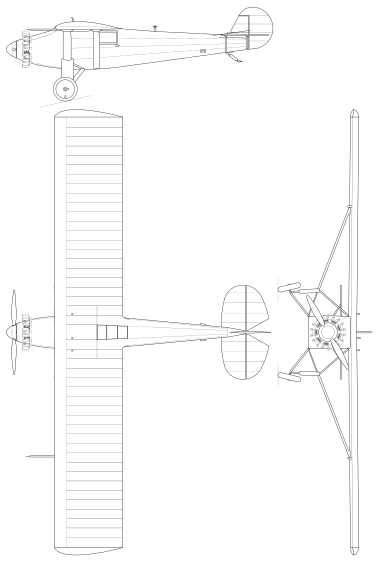Category:Spirit of St Louis
Vector-graphic plans, courtesy of MediaWiki [image info]
The Spirit of St Louis was a modified version of an American "Ryan" aircraft design, specifically tailored to win the $25,000 Orteig Prize. Piloted by Charles Lindbergh, it managed the first solo nonstop flight from New York to Paris, in 1927.
Origins
The project was organised by US airmail pilot Charles A. Lindbergh, who, as part of his job had been expected to fly gruellingly-long distances in quite atrocious weather, and who reckoned that the Atlantic couldn't possibly throw anything new at him that he hadn't already experienced and been able to cope with. Starting with his own savings of $2,000, Lindbergh convinced a number of St Louis businessmen to contribute to the project, and then approached Ryan Airlines Inc. of San Diego to ask if they could build him an aircraft capable of making the journey, based on the M1 mailplane and Whirlwind engine that Lindberg already knew and trusted.
Company owners Benjamin Franklin "Frank" Mahoney and T. Claude Ryan were enthusiastic about the project, and agreed to produce the aircraft at cost price in the 60 days necessary to meet the competition schedule rather than the three months they initially quoted, with their engineer Donald A. Hall pulling 90-hour weeks to get the project finished on time.
After Lindberg landed in Paris, he became a national hero in the US, and a famous celebrity worldwide, and the "Spirit", with it's name distinctively painted on the nose in script, (now preserved at the Smithsonian) became one of the world's most famous aeroplanes, and appeared on many book and magazine covers. Contemporary interest in the aircraft was so great that two more examples were built, as working replicas, and these are also in preservation at US aviation museums.
Contemporary models
- The level of interest in the aircraft prompted TootsieToys to produce a cast metal bodied toy of the Spirit', with a tinplate wing, and the squarish cross-section of the Spirit then let Tootsietoys use the same basic fuselage with wings attached to the top and/or bottom and windows embossed onto the sides (marked "UX214") as the basis of a range of different monoplane and biplane toys.
- In the UK, John Hill (JohillCo) produced their own versions of the toys, based on the "UX214" moulding. The two we have are recognisably the "Spirit" fuselage, albeit with the wrong number of wings(!)
External links
preservation:
Pages in category ‘Spirit of St Louis’
The following 2 pages are in this category, out of 2 total.



